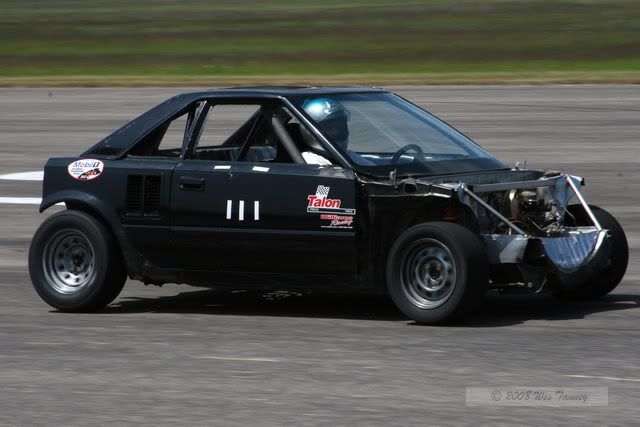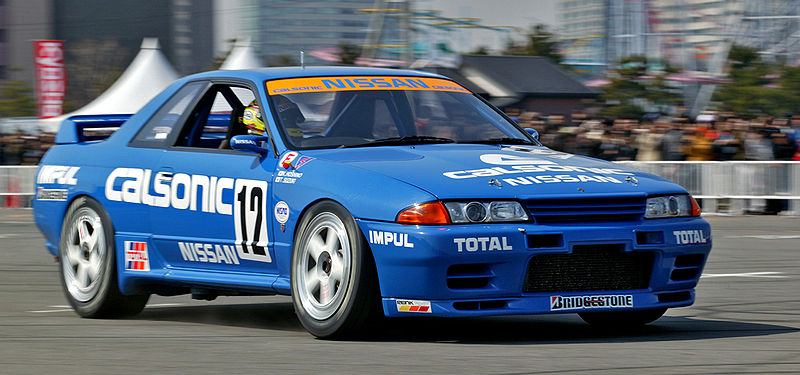I’m just busting your balls dood, it’s cool. If someone in here has a problem with that car they can go F themselves :lol
^^^forgot about that!

The fire breathing monster at her greatest:

like anyone needs to be told what that is
a red X is always self-explanatory.
looks fine over here, sir
Has it won any races?
Exactly :rofl
Vot may have missed out on this during his childhood:
Really Vot? A video game pic?
Exactly…my definition of EPIC race cars retains to those that have actually raced a real course, and um won a real title. Modding of post required…
-Adam
:rofl
i didnt know you guys meant like a trophy holding car
This car was nicknamed “Godzilla” by the Australian motoring publication “Wheels” in its July 1989 edition, a name that sticks to this day. The R32 GT-R surprisingly dominated the motorsport in Japan, winning a 29 straight victories out of 29 races. The GT-R proceeded to win the JTC Group A series championship 4 years in a row, and also had success in the Australian Touring Car Championship winning from 1990-1992, until the GT-R was outlawed in 1993. The Skyline GT-R (R33) was also the first production car to lap the legendary Nürburgring in under eight minutes.
The Skyline’s dominance in Japanese Group A racing went so far that a new race series called JGTC was inaugurated in 1993, because nobody wanted to compete against Godzilla anymore. With regulations similar to those of the German DTM, this new series was supposed to offer a platform for balanced competition. But for the first two years nothing changed compared to the previous Group A series and the Skyline won both the drivers- and constructors-championships. Which does not mean the competition was bad. With cars like the Ferrari F40 during the early days and currently the Lamborghini Diablo, Dodge Viper, McLaren F1, Mosler MT900, Honda NSX, Toyota Supra, Porsche GT2 and several others, the JGTC in fact offers an unprecedented variety of manufacturers and can be considered the best national GT-series of the world today.
But the Skyline was always up to the task, and with five drivers- and four constructors-titles throughout the last nine years, it still is by far the most successful car the JGTC has ever seen.
Only posted R32 GTR because I am running late lol. R33/34 to be up later.
Love that car.
Favorite one in gt4
vot you failed hard
hai guythss im vot vot hurr’s mah post


From the second half of the 1960s aerodynamics became increasingly more important for racing car designers. In the years before reducing drag had top priority until spoilers and wings were attached to create downforce and increase high speed stability. The newly found levels of grip in the corners more than made up for the increased drag. In 1970 aerodynamics pioneer Jim Hall came up with a novel idea to create downforce without a drag penalty. On his Chaparral 2J ‘sucker car’ he had fitted two snowmobile engine driven fans to suck the air from underneath the car and with the help of lexan skirts created a vacuum. This so called ‘ground effects’ proved to be highly effective, but the system was quickly banned as it was deemed a moveable aerodynamic device and as such illegal.
A few years later Lotus’ founder and chief designer Colin Chapman figured out a way to create ‘ground effects’ without using a fan. By giving the floor a wing profile, the air under the car was accelerated resulting in a low pressure area. Chapman first used this novel design on the 78, Lotus’ Formula 1 contender for the 1977 season. The car featured an ultra slim monocoque, constructed from an aluminium honeycomb. On both sides of the driver’s compartment the Lotus 78 sported full length side pods, which housed the radiators and created the ‘ground effects’. The low pressure area was sealed off on both sides by skirts that could slide up and down, which kept in contact with the track at all times. Conventional wings were fitted both front and rear for high-speed stability.
Powered by the familiar Cosworth DFV engine, the 78 was first shown to the public late in 1976. In the hands of Gunnar Nilsson and Mario Andretti, the new Lotus had a rocky start to its career. It had captured the imagination of the competition and they were quickly working on their own ‘ground effects’ cars even though they did not quite understand how the 78 worked. Andretti scored the first victory of the season in his home Grand Prix at Long Beach. He won another three races and Nilsson also added one to 78’s tally. Even though Andretti was the most victorious driver and the Lotus 78 was the most victorious car, both titles eluded Team Lotus due to the poor reliability. One of the problems was that the very light monocoque was not quite up to the task of handling the increased stress created by the ‘ground effects.’
Chapman knew he had a winner on his hands and went about refining the ‘ground effects’ Lotus for the 1978 season. Much of the honeycomb used for the chassis was replaced by more conventional sheet aluminium. This increased the weight by quite a bit, but it would proof to make quite a difference. To maximize the ‘ground effects’, even larger side pods were fitted to the car, which now featured full length skirts. At the rear the side pod floors swooped to create two massive Venturis. Compared to the 78, the new car featured a much cleaner and smoother body. Wind tunnel tests suggested that the Lotus 79 was 25% more effective than its predecessor. Sadly the car was not ready in time for the start of the season and Team Lotus had to make do with the 78 for the first few races of 1978.
General specifications
Country of origin Great Britain
Chassis number 79/3 / 79/4
Numbers built 5
Produced in 1978
Predecessor
Lotus 78 Cosworth
Successor
Lotus 80 Cosworth
Body design Colin Chapman with Martin Ogilvie and Geoff Aldridge for Lotus
Major wins
1978 Belgian Grand Prix (Mario Andretti in 79/2)
1978 Spanish Grand Prix (Mario Andretti in 79/3)
1978 French Grand Prix (Mario Andretti in 79/3)
1978 German Grand Prix (Mario Andretti in 79/3)
1978 Austrian Grand Prix (Ronnie Peterson in 79/2)
1978 Dutch Grand Prix (Mario Andretti in 79/4)
Engine
Configuration Ford Cosworth DFV 90º V 8
Location Mid, longitudinally mounted
Weight 147 kilo / 324.1 lbs
Construction magnesium alloy block and head
Displacement 2.993 liter / 182.6 cu in
Bore / Stroke 85.7 mm (3.4 in) / 64.8 mm (2.6 in)
Compression 11.5:1
Valvetrain 4 valves / cylinder, DOHC
Fuel feed Lucas Fuel Injection
Aspiration Naturally Aspirated
Drivetrain
Chassis/body aluminium monocoque
Front suspension upper rocker arms, lower wishbone, inboard spring/damper units
Rear suspension upper rocker arms, lower wishbones, inboard coil springs over dampers
Steering rack-and-pinion
Brakes ventilated discs, all-round
Gearbox Hewland FGA 400 5 speed Manual
Drive Rear wheel drive
Dimensions
Weight 610 kilo / 1344.8 lbs
Length / Width / Height 4420 mm (174 in) / 2146 mm (84.5 in) / 965 mm (38 in)
Wheelbase / Track (fr/r) 2743 mm (108 in) / 1730 mm (68.1 in) / 1630 mm (64.2 in)
Performance figures
Power 480 bhp / 358 KW @ 10600 rpm
Torque 353 Nm / 260 ft lbs @ 8500 rpm
BHP/Liter 160 bhp / liter
Power to weight 0.79 bhp / kg
Dittos on the Sauber and R390.
Bertone stunned the world at the 1970 Turin Motorshow with their Stratos O design. Nuccio Bertone initially wanted to call the ultra-compact wedge-shape design Stratoline because of its space-ship-like appearance. Not much on the Stratos concept was conventional, except for the fact that the wheels were round. Fitted low and midships in the chassis was a 1.6 Lancia Fulvia powerplant. The running prototype featured an all new monocoque style chassis, custom built for the Stratos.
In the next few months the concept appeared in magazines all over the world and Lancia talked with Bertone to construct a purpose built rally based on the Stratos design. This car debuted at the 1971 Turin Motorshow and resembled the previous Stratos in name only. Even though Lancia was working on a new competition engine Bertone fitted the Stratos with a Ferrari Dino engine which he had lying about. The extremely compact design looked like the winning recipe for the twisty roads used in rallies.
Nothing much happened in 1972 as Lancia was still waiting for their new competition engine. Late that year Bertone suggested that Lancia should stick with the Ferrari engine and start production of the Stratos. His suggestion received mixed reactions but works racing manager Cesare Fiorio was on his side. Finally production of the 400 cars needed for homologation started. By October 1974 the Stratos was homologated for Group 4 rallying.
Over the next couple of years the Stratos’ dominance was total. It scored 17 world championship victories and over 50 european championship victories. Victory in the legendary rally Monte Carlo rally was taken four out five times between 1975 and 1979. Two were converted to Group 5 road racing specifications with a Turbocharged engine. These silhouette-racers didn’t fare nearly as well as their Group 4 counterparts. At the end of the decade it was replaced by the Fiat 131 Mirafiori.
General specifications
Country of origin Italy
Numbers built around 50
Produced from 1974 - 1978
Body design Gandini / Bertone
Major wins
1973 Tour de France (Sandro Munari / Mario Manucci in 1577)
1974 Targa Florio (Gerard Larousse / Amilcare Bellestrieri in 1513)
Engine
Configuration Ferrari 65º V 6
Location Mid, transversely mounted
Construction alloy block and head
Displacement 2.418 liter / 147.6 cu in
Bore / Stroke 92.5 mm (3.6 in) / 60.0 mm (2.4 in)
Valvetrain 4 valves / cylinder, DOHC
Fuel feed 3 Weber 48 IDF Carburettors
Aspiration Naturally Aspirated
Drivetrain
Chassis/body fibreglass body on steel monocoque
Front suspension double wishbones, coil springs, telescopic shock absorbers, anti-roll bar
Rear suspension McPherson struts, lower wishbones, coil springs, telescopic dampers, anti-roll bar
Steering rack-and-pinion
Brakes ventilated discs, all-round
Gearbox ZF 5 speed Manual
Drive Rear wheel drive
Dimensions
Weight 880 kilo / 1940.1 lbs
Length / Width / Height 3710 mm (146.1 in) / 1810 mm (71.3 in) / 1100 mm (43.3 in)
Wheelbase / Track (fr/r) 2180 mm (85.8 in) / N/A / N/A
Performance figures
Power 280 bhp / 209 KW @ 7800 rpm
Torque 275 Nm / 203 ft lbs @ 6000 rpm
BHP/Liter 116 bhp / liter
Power to weight 0.32 bhp / kg
0-60 mph 4.9 s
0-100 mph 13.9 s


